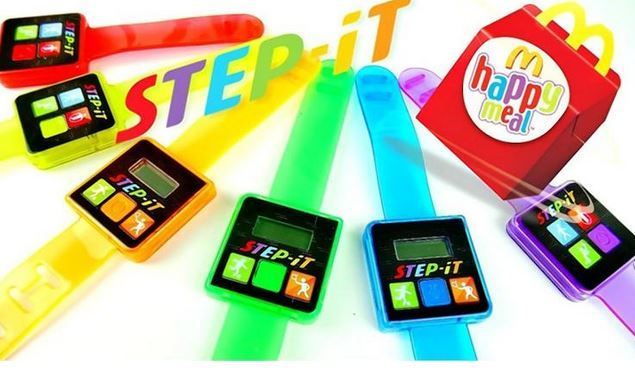 Two days before they were pulled, McDonald’s announced that they would be including fitness trackers in every Happy Meal sold in the United States and Canada. The “step-it” activity trackers were not as fancy as Fitbit devices, but they came in loud colors and blinked slowly or quickly depending on a child’s activity. The fact that the trackers were easy to use, and even easier to get, made them very appealing. They didn’t require multiple visits to collect pieces to win a prize. I know my 3 year old would love to see a light blink every time he jumped on the couch. The announcement of the devices coincided with the Olympic Games. If you have watched any Olympic coverage, you can’t miss that McDonald’s is a huge sponsor of the games. Plus, I am sure you have seen the photos of the athletes chowing down on burgers in the Olympic village. I give McDonald’s marketing kudos on this initiative that tied in their sponsorship with the Happy Meal fitness trackers – even if it lasted only two days. As expected, the McDonald’s fitness trackers have received a lot of negative attention as just another tool to reach children with fast food messaging.
Two days before they were pulled, McDonald’s announced that they would be including fitness trackers in every Happy Meal sold in the United States and Canada. The “step-it” activity trackers were not as fancy as Fitbit devices, but they came in loud colors and blinked slowly or quickly depending on a child’s activity. The fact that the trackers were easy to use, and even easier to get, made them very appealing. They didn’t require multiple visits to collect pieces to win a prize. I know my 3 year old would love to see a light blink every time he jumped on the couch. The announcement of the devices coincided with the Olympic Games. If you have watched any Olympic coverage, you can’t miss that McDonald’s is a huge sponsor of the games. Plus, I am sure you have seen the photos of the athletes chowing down on burgers in the Olympic village. I give McDonald’s marketing kudos on this initiative that tied in their sponsorship with the Happy Meal fitness trackers – even if it lasted only two days. As expected, the McDonald’s fitness trackers have received a lot of negative attention as just another tool to reach children with fast food messaging.
My thought is this – there is nothing wrong with encouraging fitness and balance in families any way that you can. Fitness bands in general may not be perfect and have been scrutinized for their inaccuracies in reporting. But overall, I think they are a positive tool to help keep physical activity top of mind, keep users motivated through accountability and help encourage a little friendly competition among friends. If you want to enjoy a Happy Meal, a fitness tracker is better than another plastic toy. The reality is people are going to eat fast food if they want it. Many parents find it a convenient way to get food that children will eat on the table when strapped for time. By providing healthier options at these establishments, such as low-fat milk instead of sugary drinks and apple slices instead of fries, you are meeting them in the middle and encouraging balance. The overall goal is to encourage families to cook and eat meals prepared at home, but I see nothing wrong with encouraging movement – unless it causes a rash.
But, not everyone feels the way I do. I spoke to Dr. Julia Nordgren, a Culinary Institute of America trained chef and practicing physician at the Palo Alto Medical Foundation in Palo Alto, California, regarding her thoughts on this subject. In her practice, Dr. Nordgren works with children with high cholesterol, pre-diabetes or metabolic syndrome.
“Toys and prizes are a big part of drawing kids to food that is, in general, far too high in saturated fat, sugar and/or salt to be health-supporting for children (or adults!),” said Nordgren. “Putting a fitness tracker in a child’s meal doesn’t improve the underlying quality of the food, nor the remarkable amount of exercise it would require to counteract the effects of consuming excess fat, salt and sugar these meals typically contain.”
What do you think about the relationship between fitness and fast food?
Disclosure: Dr. Julia Nordgren is a paid spokesperson for the Hass Avocado Board, a PadillaCRT client.
